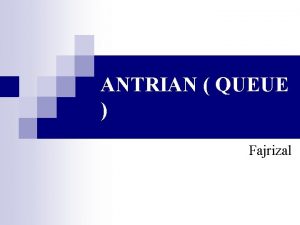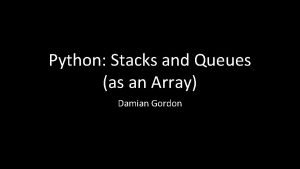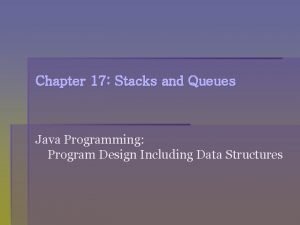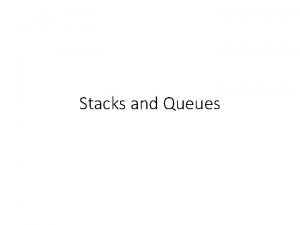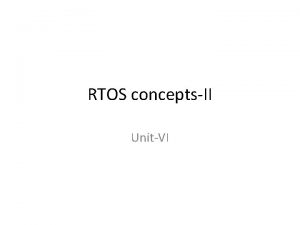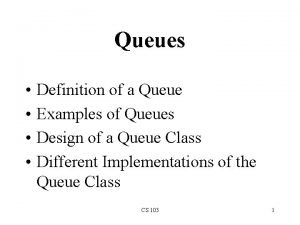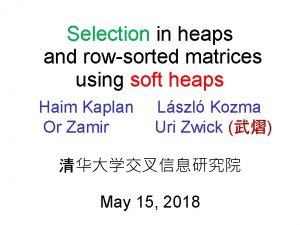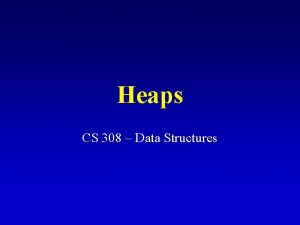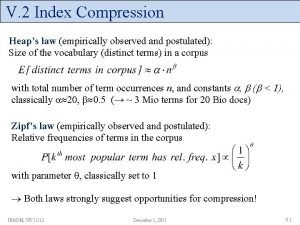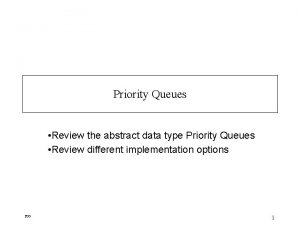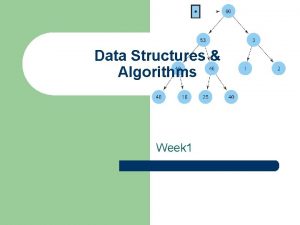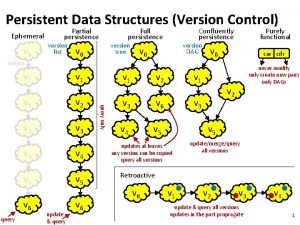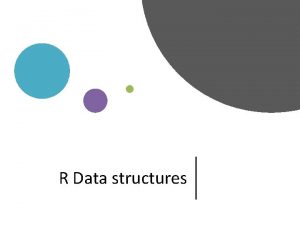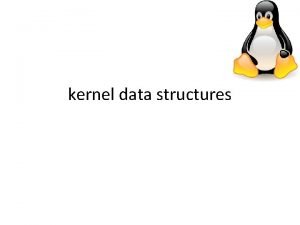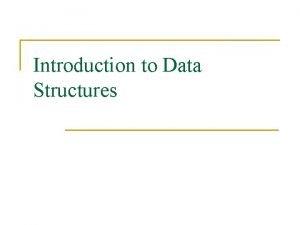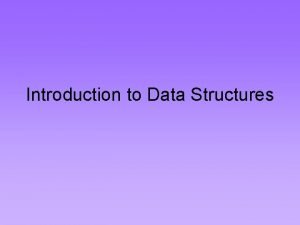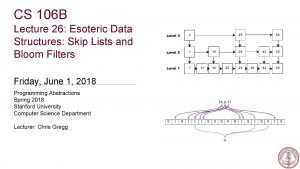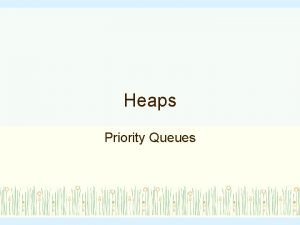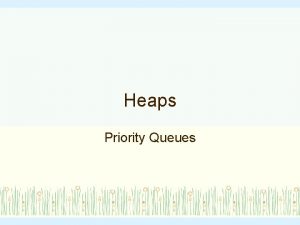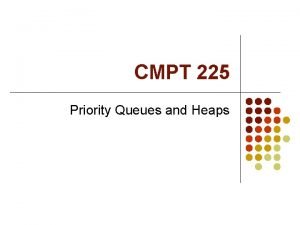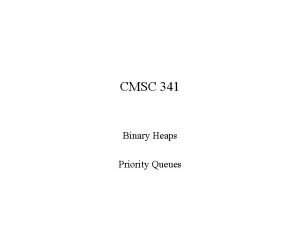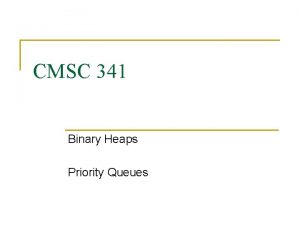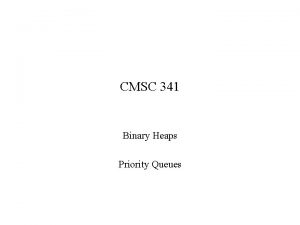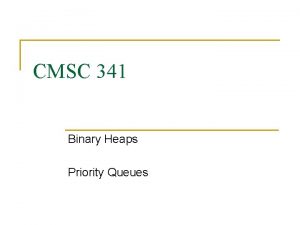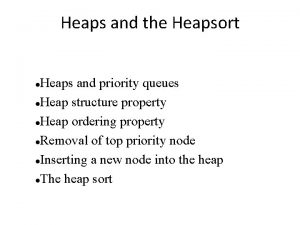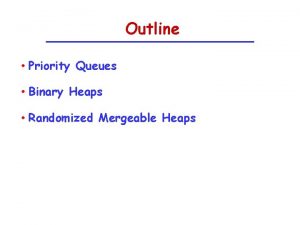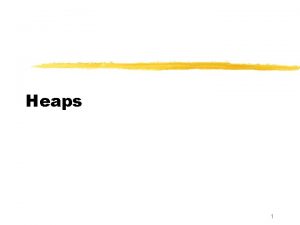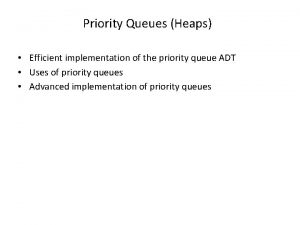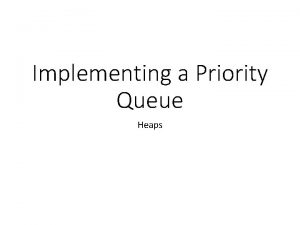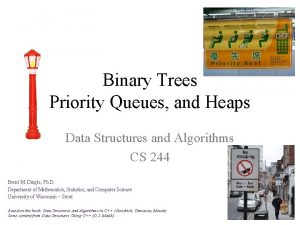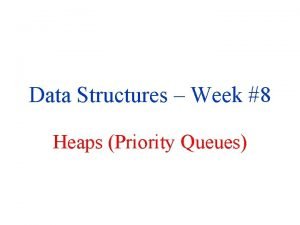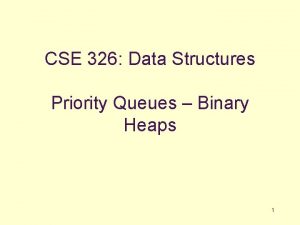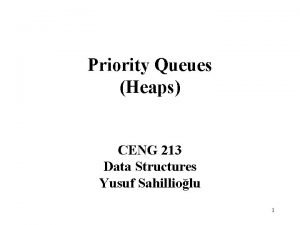Priority Queues and Heaps Data Structures and Algorithms


































![insert. Item Example Vector Representation • Here is an initial heap. [0] 45 [1] insert. Item Example Vector Representation • Here is an initial heap. [0] 45 [1]](https://slidetodoc.com/presentation_image_h2/0eae51629a41183da075f03eff59880d/image-35.jpg)


![insert. Item Example Vector Representation • Shift 42 up above its parent 21. [0] insert. Item Example Vector Representation • Shift 42 up above its parent 21. [0]](https://slidetodoc.com/presentation_image_h2/0eae51629a41183da075f03eff59880d/image-38.jpg)
![insert. Item Example Vector Representation • Shift 42 up above its parent 21. [0] insert. Item Example Vector Representation • Shift 42 up above its parent 21. [0]](https://slidetodoc.com/presentation_image_h2/0eae51629a41183da075f03eff59880d/image-39.jpg)
![insert. Item Example Vector Representation • Shift 42 up above its parent 35. [0] insert. Item Example Vector Representation • Shift 42 up above its parent 35. [0]](https://slidetodoc.com/presentation_image_h2/0eae51629a41183da075f03eff59880d/image-40.jpg)
![insert. Item Example Vector Representation • Shift 42 up above its parent 35. [0] insert. Item Example Vector Representation • Shift 42 up above its parent 35. [0]](https://slidetodoc.com/presentation_image_h2/0eae51629a41183da075f03eff59880d/image-41.jpg)


![remove. Item Example Vector • Remove and return the largest value 45. [0] 45 remove. Item Example Vector • Remove and return the largest value 45. [0] 45](https://slidetodoc.com/presentation_image_h2/0eae51629a41183da075f03eff59880d/image-44.jpg)


![remove. Item Example Vector • Replace 21 with its largest child 42. [0] 21 remove. Item Example Vector • Replace 21 with its largest child 42. [0] 21](https://slidetodoc.com/presentation_image_h2/0eae51629a41183da075f03eff59880d/image-47.jpg)
![remove. Item Example Vector • Replace 21 with its largest child 42. [0] 42 remove. Item Example Vector • Replace 21 with its largest child 42. [0] 42](https://slidetodoc.com/presentation_image_h2/0eae51629a41183da075f03eff59880d/image-48.jpg)
![remove. Item Example Vector • Replace 21 with its largest child 35. [0] 42 remove. Item Example Vector • Replace 21 with its largest child 35. [0] 42](https://slidetodoc.com/presentation_image_h2/0eae51629a41183da075f03eff59880d/image-49.jpg)
![remove. Item Example Vector • Replace 21 with its largest child 35. [0] 42 remove. Item Example Vector • Replace 21 with its largest child 35. [0] 42](https://slidetodoc.com/presentation_image_h2/0eae51629a41183da075f03eff59880d/image-50.jpg)



- Slides: 53

Priority Queues and Heaps Data Structures and Algorithms CS 244 Brent M. Dingle, Ph. D. Department of Mathematics, Statistics, and Computer Science University of Wisconsin – Stout Based on the book: Data Structures and Algorithms in C++ (Goodrich, Tamassia, Mount) Some content from Data Structures Using C++ (D. S. Malik)

Previously • Priority Queues • Implemented as Unordered List • Ordered List • Heap waiting for this • Heap Description

Marker Slide • General Questions? • Next: • Heap Review • What is a heap • How to implement a Heap • Priority Queue Implementation • Using a Heap

A Better Implementation of PQs • Priority Queues can be implemented using a Binary Heap (or just Heap for now) • A Heap is a binary tree with two properties • Structure Property • Heap-Order Property • Max Heap • Min Heap

Structure Property • A Heap is a complete binary tree Root When a complete binary tree is built, its first node must be the root.

Structure Property • A Heap is a complete binary tree Left child of the root The second node is always the left child of the root.

Structure Property • A Heap is a complete binary tree Right child of the root The third node is always the right child of the root.

Structure Property • A Heap is a complete binary tree The next nodes always fill the next level from left-to-right.

Structure Property • A Heap is a complete binary tree The next nodes always fill the next level from left-to-right.

Structure Property • A Heap is a complete binary tree The next nodes always fill the next level from left-to-right.

Structure Property • A Heap is a complete binary tree The next nodes always fill the next level from left-to-right.

Structure Property • A Heap is a complete binary tree

Structure Property • A Heap is a complete binary tree 45 35 27 19 23 21 22 Each node in a heap contains a key that can be compared to other nodes' keys. 4

Heap Order Property 45 • For a “Max. Heap” 35 • The key value of each node is at least as large as the key value of its children. 27 19 • The root of the heap is the largest value in the tree 23 21 22 The “max heap property" requires that each node's key is >= the keys of its children 4

Heap Order Property 4 • For a “Min. Heap” 19 • The key value of each node is the same or smaller than the key value of its children. • The root of the heap is the smallest value in the tree 27 35 22 21 23 45 The “min heap property" requires that each node's key is <= the keys of its children

Max Heap Examples

Not Max Heaps Not complete Root NOT largest Not complete Sub-tree 10 not a heap

Heaps Can Implement PQs • But first: how does one implement a heap?

Marker Slide • Questions On: • Heap Review • What is a heap • Next: • Heap Review • How to implement a Heap • Priority Queue Implementation • Using a Heap

Heap Implementation • A heap could be implemented using a regular binary tree (left and right child pointers) • However a heap is a complete binary tree • So we can use an array or vector instead Notice any node with index i its parent node is at (i-1)/2 its left child is at 2 i + 1 its right child is at 2 i + 2 0 2 1 3 4 5

Heap Implementation • A heap could be implemented using a regular binary tree (left and right child pointers) • However a heap is a complete binary tree • So we can use an array or vector instead (i-1)/2 Notice for any node with index i • its parent node is at (i-1)/2 • its left child is at 2 i + 1 • its right child is at 2 i + 2 Optional: Draw a NON-complete binary tree with 5 to 9 nodes Show this index relation fails to hold Parent i 2 i+1 2 i+2 Left Child Right Child

Using a Vector to Implement a Heap

Using a Vector to Implement a Heap

Using a Vector to Implement a Heap

Using a Vector to Implement a Heap

Using a Vector to Implement a Heap

Using a Vector to Implement a Heap

Using a Vector to Implement a Heap

Using a Vector to Implement a Heap

Marker Slide • Questions On: • Heap Review • What is a heap • How to implement a Heap • Next: • Priority Queue Implementation • Using a Heap

A Priority Queue Implemented with a Heap • As mentioned a PQ can be implemented using a Heap. • Each node of the heap contains one item (key and data) • Each node is keyed on priority • So in a max heap the item with the largest key is the root node • For the heap to be a priority queue we must also have 2 functions implemented • insert. Item(item) • aka enqueue(entry) • adds item to the heap and readjusts tree as needed • remove. Item() • aka dequeue() • removes the highest priority item from the heap (the root) and readjusts the tree as needed

PQ implemented as a Heap • The two PQ functions • insert. Item(item) • remove. Item() • Really are just inserting and removing a node respectively from the heap • Requires two support functions: • reheap. Up • reheap. Down • Examples follow

Priority Queue insert. Item Algorithm • insert. Item(e) Maintains complete binary tree • put e at the end of the heap (at index heap. size()-1) • reheap. Up(heap. size()-1) Maintains heap order

Priority Queue insert. Item Algorithm • insert. Item(e) Maintains complete binary tree • put e at the end of the heap (at index heap. size()-1) • reheap. Up(heap. size()-1) Maintains heap order • reheap. Up(index) • while e is not in the root && e. key > parent(e). key • swap e with its parent • Notice this swap can occur a maximum number of times equal to the height of the tree • lg N times, where N = number of nodes in the tree
![insert Item Example Vector Representation Here is an initial heap 0 45 1 insert. Item Example Vector Representation • Here is an initial heap. [0] 45 [1]](https://slidetodoc.com/presentation_image_h2/0eae51629a41183da075f03eff59880d/image-35.jpg)
insert. Item Example Vector Representation • Here is an initial heap. [0] 45 [1] 35 19 [3] 21 27 [2] 23 22 4 [4] [5] 5 [6] [7] [8] [9] [10] 45 35 23 27 21 22 4 19 5 ? ?

insert. Item Example Vector Representation • Insert 42 as leaf at back of vector. [0] 45 [1] 35 [3] 21 27 19 [2] 23 22 4 [4] [5] 5 42 [6] [7] [8] [9] [10] 45 35 23 27 21 22 4 19 5 42 ? ?

insert. Item Example Vector Representation • Insert 42 as leaf at back of vector. [0] 45 [1] 35 [3] 21 27 19 [2] 23 22 4 [4] [5] 5 42 [6] [7] [8] Fails the heap property [9] [10] 45 35 23 27 21 22 4 19 5 42 ? ?
![insert Item Example Vector Representation Shift 42 up above its parent 21 0 insert. Item Example Vector Representation • Shift 42 up above its parent 21. [0]](https://slidetodoc.com/presentation_image_h2/0eae51629a41183da075f03eff59880d/image-38.jpg)
insert. Item Example Vector Representation • Shift 42 up above its parent 21. [0] 45 [1] 35 [3] 21 27 19 [2] 23 22 4 [4] [5] 5 42 [6] [7] [8] [9] [10] 45 35 23 27 21 22 4 19 5 42 ? ?
![insert Item Example Vector Representation Shift 42 up above its parent 21 0 insert. Item Example Vector Representation • Shift 42 up above its parent 21. [0]](https://slidetodoc.com/presentation_image_h2/0eae51629a41183da075f03eff59880d/image-39.jpg)
insert. Item Example Vector Representation • Shift 42 up above its parent 21. [0] 45 [1] 35 [3] 42 27 19 [2] 23 22 4 [4] [5] 5 21 [6] [7] [8] Fails the heap property [9] [10] 45 35 23 27 42 22 4 19 5 21 ? ?
![insert Item Example Vector Representation Shift 42 up above its parent 35 0 insert. Item Example Vector Representation • Shift 42 up above its parent 35. [0]](https://slidetodoc.com/presentation_image_h2/0eae51629a41183da075f03eff59880d/image-40.jpg)
insert. Item Example Vector Representation • Shift 42 up above its parent 35. [0] 45 [1] 35 [3] 42 27 19 [2] 23 22 4 [4] [5] 5 21 [6] [7] [8] [9] [10] 45 35 23 27 42 22 4 19 5 21 ? ?
![insert Item Example Vector Representation Shift 42 up above its parent 35 0 insert. Item Example Vector Representation • Shift 42 up above its parent 35. [0]](https://slidetodoc.com/presentation_image_h2/0eae51629a41183da075f03eff59880d/image-41.jpg)
insert. Item Example Vector Representation • Shift 42 up above its parent 35. [0] 45 [1] 42 [3] 35 27 19 [2] 23 22 4 [4] [5] 5 21 [6] [7] [8] Satisfies the heap property [9] [10] 45 42 23 27 35 22 4 19 5 21 ? ?

Priority Queue remove. Item() algorithm • remove. Item Maintains complete binary tree • extract the element from the root • put the element p from the last leaf in its place • i. e. move last element to be the root • remove the last leaf • reheap. Down(0, p) Maintains heap order

Priority Queue remove. Item() algorithm • remove. Item Maintains complete binary tree • extract the element from the root • put the element p from the last leaf in its place • i. e. move last element to be the root • remove the last leaf • reheap. Down(0, p) Maintains heap order • reheap. Down(index, p) • while node (p) is not a leaf && p. key < any child’s key • swap p with child that has largest key
![remove Item Example Vector Remove and return the largest value 45 0 45 remove. Item Example Vector • Remove and return the largest value 45. [0] 45](https://slidetodoc.com/presentation_image_h2/0eae51629a41183da075f03eff59880d/image-44.jpg)
remove. Item Example Vector • Remove and return the largest value 45. [0] 45 [1] 42 [3] 35 27 19 [2] 23 22 4 [4] [5] 5 21 [6] [7] [8] [9] [10] 45 42 23 27 35 22 4 19 5 21 ? ?

remove. Item Example • Put last (back) element 21 in the root node Vector [0] [1] 42 [3] 35 27 19 [2] 23 22 4 [4] [5] 5 21 [6] [7] [8] [9] [10] 42 23 27 35 22 4 19 5 21 ? ?

remove. Item Example • Put last (back) element 21 in the root node Vector [0] 21 [1] 42 19 [3] 35 27 [2] 23 22 4 [4] [5] 5 [6] [7] [8] [9] [10] 21 42 23 27 35 22 4 19 5 ? ?
![remove Item Example Vector Replace 21 with its largest child 42 0 21 remove. Item Example Vector • Replace 21 with its largest child 42. [0] 21](https://slidetodoc.com/presentation_image_h2/0eae51629a41183da075f03eff59880d/image-47.jpg)
remove. Item Example Vector • Replace 21 with its largest child 42. [0] 21 [1] 42 19 [3] 35 27 [2] 23 22 4 [4] [5] 5 [6] [7] [8] [9] [10] 21 42 23 27 35 22 4 19 5 ? ?
![remove Item Example Vector Replace 21 with its largest child 42 0 42 remove. Item Example Vector • Replace 21 with its largest child 42. [0] 42](https://slidetodoc.com/presentation_image_h2/0eae51629a41183da075f03eff59880d/image-48.jpg)
remove. Item Example Vector • Replace 21 with its largest child 42. [0] 42 [1] 21 19 [3] 35 27 [2] 23 22 4 [4] [5] 5 [6] [7] [8] [9] [10] 42 21 23 27 35 22 4 19 5 ? ?
![remove Item Example Vector Replace 21 with its largest child 35 0 42 remove. Item Example Vector • Replace 21 with its largest child 35. [0] 42](https://slidetodoc.com/presentation_image_h2/0eae51629a41183da075f03eff59880d/image-49.jpg)
remove. Item Example Vector • Replace 21 with its largest child 35. [0] 42 [1] 21 19 [3] 35 27 [2] 23 22 4 [4] [5] 5 [6] [7] [8] [9] [10] 42 21 23 27 35 22 4 19 5 ? ?
![remove Item Example Vector Replace 21 with its largest child 35 0 42 remove. Item Example Vector • Replace 21 with its largest child 35. [0] 42](https://slidetodoc.com/presentation_image_h2/0eae51629a41183da075f03eff59880d/image-50.jpg)
remove. Item Example Vector • Replace 21 with its largest child 35. [0] 42 [1] 35 19 [3] 21 27 [2] 23 22 4 [4] [5] 5 [6] [7] [8] [9] [10] 42 35 23 27 21 22 4 19 5 ? ?

Summary of Heaps • A Max Heap • is a complete binary tree • key value of each node is at least as large as its children • So the root of the heap has the largest value • A heap can be implemented using an array • reheap. Up maintains the heap on insert. Item • reheap. Down maintains the heap on remove. Item • A priority queue can be implemented as a heap

Sorting And Priority Queues • Didn’t we mention something about sorting using priority queues there at the beginning… • Must still be in the future…

The End of This Part • End
 3 min quiz
3 min quiz Adaptable priority queue
Adaptable priority queue Applications of priority queues
Applications of priority queues Ajit diwan
Ajit diwan Cos 423 princeton
Cos 423 princeton Data structures and algorithms tutorial
Data structures and algorithms tutorial Information retrieval data structures and algorithms
Information retrieval data structures and algorithms Data structures and algorithms bits pilani
Data structures and algorithms bits pilani Ajit diwan iit bombay
Ajit diwan iit bombay Data structures and algorithms
Data structures and algorithms Data structures and algorithms
Data structures and algorithms Waterloo data structures and algorithms
Waterloo data structures and algorithms Signature file structure in information retrieval system
Signature file structure in information retrieval system Data structures and algorithms
Data structures and algorithms Algorithms + data structures = programs
Algorithms + data structures = programs Antrian q
Antrian q Burman's priority list gives priority to
Burman's priority list gives priority to Priority mail vs priority mail express
Priority mail vs priority mail express Python queue clear
Python queue clear Java stacks and queues
Java stacks and queues Java stack exercises
Java stack exercises What are stacks
What are stacks Representation of queues
Representation of queues Message queue in unix
Message queue in unix Message queues in rtos
Message queues in rtos Definition of queue
Definition of queue Martinos email
Martinos email Soft heaps of kaplan and zwick uses
Soft heaps of kaplan and zwick uses Examples of homologous
Examples of homologous Heaps of love ice cream
Heaps of love ice cream Lazy binomial heaps
Lazy binomial heaps Skew heaps
Skew heaps Mean
Mean Fibonacci
Fibonacci Heaps cs
Heaps cs Tom heaps
Tom heaps Heap's law
Heap's law Priority queue abstract data type
Priority queue abstract data type Stream data model
Stream data model Conditional macro expansion
Conditional macro expansion Assembler data structures
Assembler data structures Data structures and abstractions with java
Data structures and abstractions with java Adts, data structures, and problem solving with c++
Adts, data structures, and problem solving with c++ Data structures and algorithm
Data structures and algorithm Persistent and ephemeral data structures
Persistent and ephemeral data structures Btech smart class.com
Btech smart class.com R data structures
R data structures Oblivious data structures
Oblivious data structures Linux kernel data structures
Linux kernel data structures Introduction to data structures
Introduction to data structures Introduction to data structures
Introduction to data structures Esoteric data structures
Esoteric data structures Geometric data structures
Geometric data structures Hadoop i/o compression
Hadoop i/o compression















